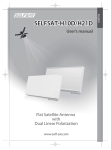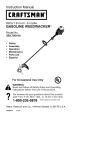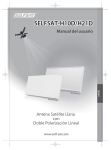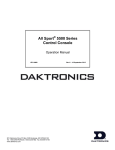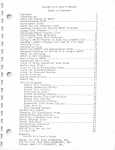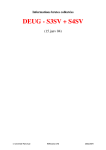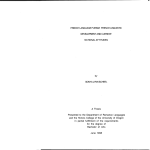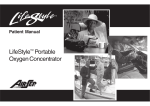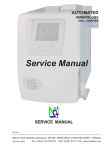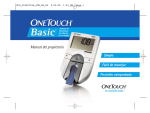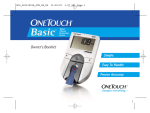Download IS/ISO 15197 (2003): In Vitro DiAGNOSTIC Test Systems
Transcript
इंटरनेट
मानक
Disclosure to Promote the Right To Information
Whereas the Parliament of India has set out to provide a practical regime of right to
information for citizens to secure access to information under the control of public authorities,
in order to promote transparency and accountability in the working of every public authority,
and whereas the attached publication of the Bureau of Indian Standards is of particular interest
to the public, particularly disadvantaged communities and those engaged in the pursuit of
education and knowledge, the attached public safety standard is made available to promote the
timely dissemination of this information in an accurate manner to the public.
“जान1 का अ+धकार, जी1 का अ+धकार”
“प0रा1 को छोड न' 5 तरफ”
“The Right to Information, The Right to Live”
“Step Out From the Old to the New”
Mazdoor Kisan Shakti Sangathan
Jawaharlal Nehru
IS/ISO 15197 (2003): In Vitro DiAGNOSTIC Test Systems Requirements for Bloos-Glucose Monitoring Systems for Self
- Testing in Managing Diabetes Mellitus [MHD 16: Surgical
Dressings and Disposable Products]
“!ान $ एक न' भारत का +नम-ण”
Satyanarayan Gangaram Pitroda
“Invent a New India Using Knowledge”
“!ान एक ऐसा खजाना > जो कभी च0राया नहB जा सकता ह”
है”
ह
Bhartṛhari—Nītiśatakam
“Knowledge is such a treasure which cannot be stolen”
ISIISO 15197: 2003
~ ftrtt~ qfr~ -~ - ~ ~
cFi
-q
~
~ ~-qfr~
CfiB cFi ~ ~ -q
~etr.~%g0N~
Indian Standard
IN VITRO DIAGNOSTIC TEST SYSTEMS REQUIREMENTS FOR BLOOD-GLUCOSE
MONITORING SYSTEMS FOR SELF-TESTING IN
MANAGING DIABETES MELLITUS
ICS 11.100
© BIS 2010
BUREAU OF INDIAN STANDARDS
MANAK BHAVAN, 9 BAHA£?UR SHAH ZAFAR MARG
NEW DELHI 110002
May 2010
Price Groyp 11
IS/ISO 15197: 2003
Surgical Disposables and Dressings Sectional Committee. MHO 16
NATIONAL FOREWORD
This Indian Standard which is identical with ISO 15197: 2003 'In vitro diagnostic test systems - Requirements
for blood-glucose monitoring systems for self-testing in managing diabetes mellitus' issued by the International
Organization for Standardization (ISO) was adopted by the Bureau of Indian Standards on the recommendation
of the Surgical Disposables and Dressings Sectional Committee and approval of the Medical Equipment and
Hospital Planning Division Council.
Blood-glucose monitoring systems are in vitro diagnostic medical devices used predominantly by individuals
affected by diabetes mellitus. Diabetes mellitus is caused by a relative or absolute deficiency in insulin
secretion or by insulin resistance leading to abnormal concentrations of glucose in the blood, which may
result in acute and chronic health complications. When used properly a glucose monitoring system allows
the user to monitor and take action to control the concentration of glucose present in the blood.
This standard is intended for blood-glucose monitoring systems used by laypersons. The primary objectives
are to establish requirements that result in acceptable performance and to specify procedures for demonstrating
conformance to this standard.
Performance criteria for blood-glucose monitoring systems were established from the accuracy (precision
and trueness) required for individual glucose results. System accuracy criteria, also known in the in vitro
diagnostics (IVD) industry as total error criteria [see NeClS EP 21-P(35)], are used in this standard because
some of the metrological terms commonly used in this standard (for example, uncertainty) would not 'be
familiar to lay users. System accuracy, which is affected by systematic bias and measurement uncertainty,
describes the degree to which individual results produced by a glucose monitoring system agree with the
true glucose values when the system is used as intended by laypersons.
The criteria for system accuracy are based on three considerations:
a)
The effectiveness of current technology for monitoring patients with diabetes mellitus, as demonstrated
in clinical outcome studies using state-of-the-art monitoring devices;
b)
Recommendations of diabetes researchers as well as existing product standards and regulatory
guidelines; and
c)
The state-of-the-art of currently available technology, as evidenced by the performance of existing
commercial products.
In arriving at the performance criteria, desirable goals has to be weighed against the capabilities of existing
devices (the current state-of-the-art) and their effectiveness in clinical outcome studies. It was decided that
overly demanding performance requirements would cause manufacturers to focus design improvements on
analytical performance at the expense of other important attributes. For example frequency of testing by
diabetic patients can be as important as the accuracy of an individual result, and greater convenience of
glucose self-testing improves patient compliance. The system accuracy criteria define the minimum acceptable
performance of a blood-glucose measuring device intended for self-monitoring.
Future advances in technology are expected, which should result in improved performance of glucose monitoring
devices. Such performance improvements will be driven by the competitive marketplace, particularly through
reduction of dependence on user technique.
Requirements that are unique to self-monitoring devices for blood-glucose, including the content of information
supplied by the manufacturer, are addressed in this standard. General requirements that apply to all in vitro
ISIISO 15197: 2003
diagnostic medical devices and are covered by other standards (for example, IS 15579 and ISO 14971) are
incorporated by reference where appropriate.
Although this standard does not apply to measurement procedures with results on an ordinal scale (for
example, visual, semi-quantitative measurement procedures), it may be useful as a guide for developing
procedures to evaluate the performance of such systems.
The text of ISO Standard has been approved as suitable for publication as an Indian Standard without
deviations. Certain conventions are, however, not identical to those used in Indian Standards. Attention is
particularly drawn to the following:
. a) Wherever the words 'International Standard' appear referring to this standard, they should be read as
'Indian Standard'.
b) Comma (,) has been used as a decimal marker in the International Standard while in Indian Standards,
the current practice is to use a point (.) as the decimal marker.
In this adopted standard, reference appears to the tollowinq International Standard for which Indian Standard
also exists. The corresponding Indian Standard which is to be substituted in its place is listed below along
with its degree of equivalence for the edition indicated:
International Standard
Corresponding Indian Standard
Degree of Equivalence
ISO 13485 : 2003 Medical devices Quality management systems Requirements for regulatory purposes
IS 15579 : 2005 Medical devices Quality management systems Requirements for regulatory purposes
Identical
The technical committee has reviewed the provisions of the following International Standards referred in this
adopted standard and has decided that they are acceptable for use in conjunction with this standard:
International/Other Standard
Title
ISO 14971 : 2007
Medical devices -
ISO 17511 : 2003
In vitro diagnostic medical devices - Measurement of quantities in biological
samples - Metrological traceability of values assigned to calibrators and
controlled materials
IEC 60068-2-64 : 1993
Environmental testing - Part 2: Test methods - Test Fh: Vibration, broadband random (digital control) and guidance
IEC 61010-1 : 2001
Safety requirements for electrical equipment for measurement, control and
laboratory use - Part 1: General requirements
IEC 61010-2-101 : 2002
Safety requirements for electrical equipment for electrical equipment for
measurement, control and laboratory use - Part 2-101: Particular.
requirements for in vitro diagnostic (IVD) medical equipment
IEC 61000-4-2 : 2008
Electromagnetic compatibility (EMC) - Part 4-2: Testing and measurement
techniques - Electrostatic discharge immunity test
IEC 61000-4-3: 2006
Electromagnetic compatibility (EMC) - Part 4-3: Testing and measurement
techniques - Radiated, radio-frequency electromagnetic field immunity
test
llSince revised in various parts and sections.
ii
Application of risk management to medical devices
ISIISO 15197: 2003
International/Other Standard
Title
IEC 61326: 2002
Electrical equipment for measurement,.control and laboratory use - EMC
requirements
EN 376 : 2002
Information supplied by the manufactures with in vitro diagnostic reagents
for self-testing
EN 13612: 2002
Performance evaluation of in vitro diagnostic medical devices
EN 13640 : 2002
Stability testing of in vitro diagnostic reagents
The Standard also makes a reference to the SIS certification marking of the product. Details of which is
given in National Annex A.
For the purpose of deciding whether a particular requirement of this standard is complied with, the final
value, observed or calculated, expressing the result of a test or analysis, shall be rounded off in accordance
with IS 2 : 1960 'Rules for rounding off numerical values (revised)'. The number of significant places retained
in the rounded off value should be same as that of the specified value in this standard.
ii i .
IS/ISO 15197: 2003
Indian Standard
IN VITRO DIAGNOSTIC TEST SYSTEMS
REQUIREMENTS FOR BLOOD-GLUCOSE
MONITORING SYSTEMS FOR SELF-TESTING IN
MANAGING DIABETES MELLITUS
1
Scope
This International Standard specifies requirements for in vitro glucose monitoring systems that measure
glucose concentrations in capillary blood samples and procedures for the verification and the validation of
performance by the intended users. These systems are intended for self-testing by laypersons for
management of diabetes mellitus.
This International Standard is applicable to manufacturers of such systems and those other organizations
(e.g. requlatory authorities and conformity assessment bodies) having the responsibility for assessing the
performance of these systems.
This International Standard does not
provide a comprehensive evaluation of all possible factors that could affect the performance of these
systems,
pertain to glucose concentration measurement for the purpose of diagnosing diabetes mellitus,
address the medical aspects of diabetes mellitus management, or
apply to measurement procedures with results on an ordinal scale (e.g. visual, semiquantitative test
methods).
2
Normative references
The following referenced documents are indispensable for the application of this document. For dated
references, only the edition cited applies. For undated references, the latest edition of the referenced
document (including any amendments) applies.
ISO 13485, Medical devices -
Quality management systems - Requirements for regulatory purposes
ISO 14971, Medical devices -
Application of risk management to medical devices
ISO 17511:_1) In vitro diagnostic medical devices - Measurement of quantities in biological samplesMetrological traceability of values assigned to calibrators and control materials
IEC 60068-2-64:1993, Environmental testing random (digital control) and guidance
Part 2: Test methods -
Test Fh: Vibration, broad-band
o
~
~
en
iii
~
CD
~
IEC 61010-1 :2001, Safety requirements for electrical equipment for measurement, control, and laboratory
use - Part 1: General requirements
IEC 61010-2-101:2002, Safety requirements for electrical equipment for measurement, control and laboratory
use - Part 2-101: Particular requirements for in vitro diagnostic (IVD) medical equipment
1)
To be published.
1
ISIISO 15197: 2003
IEC 61000-4-2, Electromagnetic compatibility (EMC) Electrostatic discharge immunity test
Part 4-2: Testing and measurement techniques-
IEC 61000-4-3, Electromagnetic compatibility (EMC) - Part 4-3: Testing and measurement techniquesRadiated, radio-frequency, electromagnetic field immunity test
IEC 61326, Electrical equipment- for measurement, control and laboratory use -
EMC requirements
EN 376, Information supplied by the manufacturer with in vitro diagnostic reagents for self-testing
EN 13612, Performance evaluation of in vitro diagnostic medical devices
EN 13640, Stability testing of in vitro diagnostic reagents
3
Terms and definitions
For the purposes of this document, the following terms and definitions apply.
3.1
accuracy
closeness of agreement between a test result and the accepted reference value
[ISO 3534-1:1993]
NOTE 1
The term "accuracy", when applied to a set of test results, involves a combination of random error components
and a common systematic error or bias component. [VIM:1993]
NOTE 2
For a measure of the accuracy of results of a blood-glucose monitoring system, see 3.24.
3.2
bias
difference between the expectation of the test results and an accepted reference value
[ISO 5725-1 :1994]
3.3
blood-qlucose monitoring system
measuring system consisting of a portable instrument and reagents used for the in vitro monitoring of glucose
concentrations in blood
NOTE
Blood-glucose monitoring systems measure glucose in capillary blood samples, but may express results as
either the gl\,:Jcose concentration in blood or the equivalent glucose concentration in plasma. Concentrations in this
International Standard refer to the type of results reported by the system.
3.4
blood-glucose meter
component of a blood-glucose monitoring system that converts the result of a chemical reaction into the
glucose concentration of the sample
3.5
commutability of a material
ability of a material to yield the same numerical relationships between results of measurements by a given set
of measurement procedures, .purportinq to measure the same quantity, as those between the expectations of
the relationships obtained when the same procedures are applied to other relevant types of material
[ISO 15194:2002]
NOTE
For reference materials used to calibrate measurement procedures intended for biological samples, "other
relevant types of material" include a large number of samples from healthy and relevantly diseased individuals.
2
ISIISO 15197: 2003
3.6
control material
substance, material, or article intended by the manufacturer to be used to verify the performance
characteristics of an in vitro diagnostic medical device
[EN 375:2001]
3.7
information supplied by the manufacturer with the medical device
all written, printed, or graphic matter on a medical device or any of its containers or wrappers, or
accompanying a medical device, relating to the identification, technical description and use of the medical
device, but excluding shipping documentation and promotional material
NOTE 1
Adapted from EN 1041:1998.
NOTE 2
In some countries, information supplied by the manufacturer is called "labelling".
3.8
instructions for use
information supplied by the manufacturer with an in vitro diagnostic medical device concerning the safe and
proper use of the reagent or the safe and correct operation, maintenance, and basic troubleshooting of the
instrument
NOTE 1
Adapted from EN 375:2001 and EN 591:2001.
NOTE 2
Instructions for use for in vitro diagnostic reagents for self-testing is described in EN 376.
NOTE 3
Instructions for use for in vitro diagnostic instruments for self-testing is described in EN 592.
NOTE 4
Instructions for use may take the form of package insert sheets and/or user manuals.
3.9
intermediate precision
precision under conditions intermediate between reproducibility conditions and repeatability conditions
NOTE
The concept of intermediate levels of precision is described in ISO 5725-3:1994.
3.10
intermediate precision conditions
conditions where independent test results are obtained with the same method on identical test items in the
same location. but where other variables such as operators. equipment. calibration. environmental conditions
and/or time intervals differ
NOTE
Intended to measure precision in conditions leading to variability representative of actual use. Quantitative
measures of intermediate precision depend on the stipulated conditions.
3.11
label
printed. written. or graphic information placed on a device or container
NOTE
Adapted from EN 375:2001.
3.12
layperson
individual who does not have formal'training in a specific field or discipline
NOTE 1
Adapted from the definition of "lay user" in EN 376:2002.
NOTE 2
For the purposes of this"lntemational Standard. a user of a -blood-glucose monitoring device who does not
have specific medical, scientific or technical knowledqe related to blood-glucose monitoring.
3
ISIISO -15197 : 2003
3.13
lot
batch
one or more components or finished devices that consist of a single type, model, class, size, composition, or
software version that are manufactured under essentially the same conditions and that are intended to have
uniform characteristics and quality within specified limits
NOTE
In Directive 98/79/EC[37) and 'in European Standards the term "batch" is preferred.
3.14
manufacturer's selected measurement procedure
measurement procedure that is calibrated by one or more primary or secondary, calibrators and validated for
its intended use
NOTE
ISO 17511:-, 4.2.2 f), shows the manufacturer's selected measurement procedure in the traceability chain.
3.15
manufacturer's standing measurement procedure
measurement procedure that is calibrated by one or more of the manufacturer's working calibrators or higher
types of calibrator and validated for its intended use
NOTE
ISO 17511:-, 4.2.2 h) shows the manufacturer's standing measurement procedure in the traceability chain.
3.16
package insert
instructions for use and other information for the reagent system or control material that is supplied within the
package, but not attached to any part of the package
3.17
packed cell volume
volume fraction of the erythrocytes in blood
NOTE 1
Expressed either as a decimal fraction (SI) or as a percentage (conventional). SI units (LlL) are implied.
NOTE 2
Sometimes referred to as "haematocrit" after the instrument originally used to estimate packed cell volume.
3.18
precision of measurement
closeness of agreement between independent test results obtained under stipulated conditions
[ISO 3534-1: 1993]
NOTE 1
The degree of precision is expressed numerically by the statistical measures of imprecision of measurements,
such as standard deviation and coefficient of variation, that are inversely related to precision. Quantitative measures of
precision depend on the stipulated conditions.
NOTE 2
Precision of a given measurement procedure is subdivided according to the specified precision conditions.
Particular sets of extreme conditions are termed "repeatability" (3.20) and "reproducibility" (3.22).
3.19
reagent system
part of the in vitro diagnostic medical device that produces a signal via a chemical or electrochemical reaction,
which allows the analyte (e.g. glucose) in a sample to be detected and its concentration measured
3.20
repeatability
precision under repeatability conditions
[ISO 3534-1: 1993]
4
ISIISO 15197: 2003
3.21
repeatability conditions
conditions where independent test results are obtained with the same method on identical test items in the
same laboratory by the same operator using the same equipment within short intervals of time
[ISO 3534-1 :1993]
NOTE 1
results.
Essentially unchanged conditions, intended to represent conditions resulting in minimum variability of test
NOTE 2
For the purposes of this International Standard, "laboratories" should be interpreted as "locations.
3.22
reproducibility
precision under reproducibility conditions
[ISO 3534-1: 1993]
3.23
reproducibility conditions
conditions where test results are obtained with" the same method on identical test items in different
laboratories with different operators using different equipment
[ISO 3534-1: 1993]
NOTE 1
results.
Completely changed conditions, intended to represent conditions resulting in maximum variability of test
NOTE 2
For the purposes of this International Standard, "laboratories" should be interpreted as "locations".
3.24
system accuracy
closeness of agreement of a set of representative test results from a measuring system and their respective
reference values
NOTE 1
The term .accuracy, when applied to a set of test results, involves a combination of random error components
and a common systematic error or bias component. [VIM:1993]
NOTE 2
Reference values are assigned by a measurement procedure traceable to a reference measurement
procedure of higher order.
NOTE 3
System accuracy may be expressed as the interval that encompasses 95 % of the differences observed
between the results of the system being evaluated and their reference values. This interval also includes measurement
uncertainty from the measurement procedure used to assign the reference values.
3.25
traceability
property of the result of a measurement or the value of a standard whereby it can be related to stated
references, usually national or international standards, through an unbroken chain of comparisons all having
stated uncertainties
[VIM:1993,6.10]
3.26
trueness
closeness of agreement between the average value obtained from a large", series of test results and an
accepted reference value
[ISO 3534-1 :1993]
NOTE
The measure of trueness is usually expressed in terms of bias (3.2).
5
ISIISO 15197: 2003
3.27
type test
test of one or more samples of equipment (or parts of equipment) made to a particular design, to show that
the design and construction meet one or more requirements of the applicable standard
NOTE 1
Statistical sampling is not required for blood-glucose monitoring equipment.
NOTE 2
Ada~ted
from IEC 61326.
3.28
user adjustment of blood-glucose monitoring system
procedure described in the instructions for use in which the user enters a number, inserts a code strip or chip,
etc., so that the system achieves acceptable performance characteristics
4
4.1
Design and development
General requirements
The requirements specified in ISO 13485 apply.
NOTE
Clause 6, 7.2 and 7.3 describe design verification activities, which are intended to provide assurance that the
system has the capability of meeting its precision, trueness, safety, and reliability specifications. Clause 8 describes
design validation activities, which are intended to provide assurance that system accuracy meets user requirements.
4.2
Safety
The requirements specified in IEC 61010-1 and IEC 61010-2-101 apply.
4.3
Traceability
The requirements specified in ISO 17511 apply to the manufacturer's calibration process.
NOTE 1
The manufacturer's selected or standing measurement procedure may measure glucose in either blood or
plasma samples. If plasma samples are used, the blood-glucose monitoring system may report results as plasma glucose
equivalents, even though the samples measured by the blood-glucose monitoring system are blood.
NOTE 2
The traceability chain should include as few steps as practical to minimize combined uncertainty.
NOTE 3
A traceability chain for a typical factory-calibrated blood-glucose monitoring system is shown in Annex B. This
example is not intended to represent the only possibility of a suitable traceability chain.
4.4
Ergonomic/human'factor aspects
. The design of the blood-glucose monitoring system shall take into consideration ergonomic and relevant
'human factors for the following:
a)
ease of operation;
b)
ease of maintenance;
c)
protection from "wear and tear" that might typically be encountered in the use environment;
d)
readability of the measured results;
e)
unambiguous messages to the user, e.g. "low battery" or "low result", rather than simply "low".
NOTE 1
Blood-glucose monitoring systems intended for self-measurement may be used by laypersons with different
physical and mental abilities.
6
ISIISO 15197: 2003
NOTE 2
settings.
These systems are often transported by the individual users, who may conduct measurements in a variety of
NOTE 3
settings.
It is not expected that a single blood-glucose monitoring system will meet the needs of all possible users or
4~5
Risk analysis
The requirements specified in ISO 14971 apply.
The manufacturer shall decide the acceptability of potential risks from knowledge of factors including but not
limited to
a) intended use of the product,
b) users' skills and limitations,
c)
protection against unintentional change of essential parameters (e.g. units reported), or
d) influence of interfering substances.
NOTE
Guidelines for evaluating potentially interfering substances are found in NCClS EP7-A[311.
In performing risk analysis, the manufacturer shall evaluate the
e)
probability of occurrence of a failure (e.g. insufficient sample volume or incorrect test strip placement),
f)
probability of the system not detecting a failure, and
g)
consequences of an undetected failure.
NOTE
4.6
This International Standard does not specify levels of risk and acceptability.
User verification
The design of the blood-glucose monitoring system shall allow the user to check:
a)
correct functioning of the blood-glucose monitoring system, (i.e. system control); and
b)
correct execution of the test including the sequence of the procedural steps.
NOTE
User verification should be done at the time of use. "At the time of use" means before, during, or immediately
after the execution of the test. User verification should be integrated into the test if reasonably possible.
User verification shall give unambiguous information.
5
5.1
Information supplied by the manufacturer
Labels for the blood-glucose meter
The blood-glucose meter shall be identified by labels including, at a minimum, the following information:
a}
name or trade name of the manufacturer and address of the manufacturer;
b}
product name or designation (this information shall directly appear on a label affixed to the device);
c}
intended purpose (a statement that the device is an in vitro diagnostic medical device for self-testing shall
be included, as well as information regarding the reagent system to be used with the device);
7
ISIISO 15197: 2003
d)
lot or serial number appearing directly on a label affixed to the device;
e)
conditions for storage and handling, if appropriate;
f)
a reference to the user manual or instructions for use.
Where appropriate, information on the label should take the form of symbols. Symbols shall conform to
applicable regulations and International Standards. All symbols shall be described in the information supplied
with the blood-glucose meter.
5.2
Instructions for use for the blood-glucose monitoring system
The instructions for use shall be presented in a clear and concise manner, using plain terminology that is
readily understood by a layperson. The information shall be well organized and easy to read. The print shall
be large (e.g. 12-point Courier) and the content shall be readily understandable by persons without a scientific
or technical backqround. Symbols and illustrations shall be used where appropriate.
The instructions for use shall clearly state what actions to take if the verification indicates an invalid result.
The language(s) of the country in which the blood-glucose monitoring system is distributed shall be used.
Additional languages are optional.
The instructions for use shall include the following information:
a)
name or trade name and address of the manufacturer, the name and address of the distributor (if
applicable) (in the European Union, Directive 98/79/EC[37] requires the name and address of the
"authorized representative" if the manufacturer is not located in the European Union), and how to access
help;
b)
product name or designation;
c)
intended purpose of the device;
d)
the principle of the method;
e)
measurement procedures and/or calibrator materials (traceability to a reference measurement procedure
and/or reference material of higher order should be indicated, if applicable) used by the manufacturer to
establish and evaluate performance characteristics;
f)
the type of samples used by the manufacturer for calibration, e.g. blood or plasma;
g)
proper reagent system to be used;
h)
measurement procedure to be followed when using the device, including:
the sequence of adjustment (e.g. use of a number, code strip, code chip, etc.), measurement and
verification, and the allocated time intervals between them;
the sequence of steps to prepare the instrument for the measurement, to execute the measurement
(including the amount and recommended appearance of the sample) and to maintain the instrument
after the measurement;
the measurement units reported by the device, e.g. mmol/L or mg/dL;
whether reported results are equivalent to blood or plasma results;
advice on how to proceed when an error message is generated by the meter;
i)
8
environmental conditions (e.g. temperature and humidity range) under which the system shall be used;
ISIISO 1'5197: 2003-
j)
detailed procedure to be followed by the user in adjusting the device, if applicable;
k)
detailed user control procedures, including identification of the appropriate control material to be used to
assure that the blood-glucose monitoring system is operating properly and advice on how to proceed if
control results are not acceptable;
I)
type of sample to be used, as well as any special conditions of collection and pretreatment;
m) precautions to be taken against the risk of infection from prior use of the instrument;
n)
precautions to be taken regarding electrostatic discharge, magnetic fields, and other electrical conditions,
as well as exposure to temperature, humidity, and other environmental conditions, as applicable (see
IEC 61010-2-101 :2002, Clause 5);
0)
description and explanation of all symbols used on labels and in the instructions for use;
p)
guidance on action to.be taken by the user as a consequence of the result, including:
a reference to the instructions given by a physician and/or other qualified healthcare provider, and a
warning not to deviate from these instructions on the basis of the result without first consulting the
physician or other qualified healthcare provider;
advice on how to proceed if the result appears to be questionable to the user;
indication how the monitoring system alerts the user when the result is outside the "measurement
interval" (e.g. error messages, fault notifications);
q)
information on the safe disposal of the system and its components, where appropriate;
r)
the year and month of issue of the instructions for use and/or the revision number.
5.3
Labels for the reagent system and control material
The reagent system and control material shall be identified by a label or labels.
The requirements specified in EN 376 apply.
In addition, the following information shall be included on the label(s):
a)
indication of the period of time during which the reagent should be used after the first opening of the
immediate reagent container, expressed as months and/or days;
b)
a reference to the instructions for use;
c)
the blood-glucose meter to be used with the reagents.
Warning statements concerning use of the reagent system with the specified blood-glucose meter and
disposal of the reagent system after use should be included on the label to promote reliable measurement
results and safe reagent disposal.
~
2i
z
en
The language(s) of the country in which the reagents and control materials are distributed shall be used;
additional languages are optional.
m
9
IS/ISO 15197: 2003
5.4
Instructions for use for reagents and control material
The requirements specified in EN 376 apply.
In addition, the following information shall be included:
a)
an indication of how to access help from the manufacturer and/or distributor;
b)
the specific btood-qlucose meter to be used with the reagent system and control material;
c)
the storage conditions, (e.g. temperature, humidity, exposure to light, and other environmental factors) (a
warning statement concerning the need to tightly seal the cap of the container provided to protect reagent
strips or sensors from exposure to air should be included in the instructions for use for reagents);
d)
the measurement interval, indicating the upper and lower concentration limits within which the glucose
results are accurate and reportable;
e)
the performance characteristics (those related to system accuracy are based on the results of testing
performed as described in Clause 7) stated in language that is understandable by the intended user and
for system accuracy performance (see 7.4.2), the manufacturer shall report:
for glucose concentrations < 4,2 mmol/L (75 mg/dL), the percentage of results within ± 0,28 mmol/L,
± 0,56 mmol/L and ± 0,83 mmol/L (± 5 mg/dL, ± 10 mg/dL and ± 15 mg/dL) of the reference values;
for glucose concentrations
~
4,2 mmol/L (75 mg/dL), the percentage of results within ± 5 %, ± 10 %,
± 15 % and ± 20 % of the reference values;
f)
any interfering substances, sample conditions (e.g. haemolysis, icterus, lipemia) or physiological
conditions (e.g. changes in peripheral circulation) known to affect the accuracy of results;
g)
the measurement procedure used to evaluate the performance charactenstics of the system, and a
statement describing its traceability to a glucose reference measurement procedure or reference material
of higher order;
h)
the reference interval for capillary blood-glucose concentrations in nondiabetic individuals and the type of
samples used for calibration (blood or plasma);
i)
the measurement procedure to be followed, including:
the sequence of steps to prepare the reagent system and execute the measurement;
the timing between the individual steps, if applicable;
j)
the detailed control proceaures and control materials to be used to verify that the blood-glucose
monitoring system is operating within its performance specifications..
The language(s) of the country in which the reagents and control materials are distributed shall be used;
additional languages are optional.
Required information regarding reagents and/or control materials may be included in the instructions for use
for the instrument or system if the manufacturer of the instrument or system is the same as the manufacturer
of the reagents. If there is a change in this information; reagent labels should be used to notify the user, and
the changed information shall be placed; in the instructions for use for the reagent system.
10
ISIISO 15197: 2003
6
Safety and reliability testing
6.1
General requirements
6.1.1
Protocol'
Experimental designs, data analysis procedures and acceptance criteria shall be described in a protocol.
The protocol shall specify the number of meters, reagent units, and replicate measurements per meter.
For performance tests, the protocol shall include statistical rationale.
Specified testing requirements are minimum requirements.
NOTE 1
The tests described in 6.9 to 6.12 are performance tests.
NOTE 2
The tests described in 6.2 to 6.8 are type tests.
6.1.2
Meters and reagent systems
Meters and reagent systems shall be representative of routine production units.
For performance tests, at least ten meters shall be used in each test.
For type tests, three meters should be used in each test.
6.1.3
Acceptance criteria
Acceptance criteria for bias and repeatability for the performance tests in 6.10 to 6.13 should be derived from
the system accuracy criteria in 7.4. The rationale shall be documented in the protocol.
The blood-glucose monitoring system shall pass the acceptance criteria in each test protocol. Alternatively,
the system shall be rendered nonfunctional and shall not display a numerical glucose result.
Failures to meet acceptance criteria shall be investigated.
6.2
Protection against electric shock
The requirements specified in IEC 61010-1:2001, Clause 6, apply.
6.3
Protection against mechanical hazards
The requirements specified in IEC 61010-1:2001, Clause 7, apply.
6.4
Electromagnetic compatibility
The requirements specified in IEC 61326 apply.
In addition, the requirements specified in Annex A apply.
6.5
Resistance to heat
The requirements specified in IEC 61010-1 :2001, Clause 10, apply.
6.6
Resistance to moisture and liquids
The requirements specified in IEC 61010-1:2001,11.1,11.2 and 11.3, apply.
11
ISIISO 15197:2003
6.7
Protection against liberated gases, explosion and implosion
The requirements specified in lEG 61010-1:2001,13.1 and 13.2.2, apply.
6.8
Meter components
The requirements specified in lEG 61010-1:2001,14.1,14.4,14.5 and 14.6, apply.
6.9
Performance test
The performance test shall be performed before and after each determination of mechanical resistance to
shock, vibration and impact (see 6.10) and protection against exposure to temperature and humidity levels
(see 6.11 and 6.12). Pass/fail criteria shall be based on the effect of the challenge on system bias and
repeatability.
Prior to each performance test the blood-glucose meter shall be equilibrated to 23 °G ± 2 "C.
The manufacturer's recommended control material or a suitable alternative should be used for the
performance tests.
It may be difficult to separate the variability due to sample and reagent system components from meter
components. This should be taken into consideration when designing the test and developing acceptance
criteria.
A check strip, which simulates a reagent strip after reaction with glucose, or other similar alternative to
analysing the manufacturer's recommended control material, may be used to verify that measurement system
performance has not been affected.
Test samples shall be measured in the order specified in the protocol.
Mean glucose concentration and repeatability shall be calculated before and after each challenge, and the
difference compared to the acceptance criteria.
a)
Mean glucose concentration: the difference between the mean glucose concentration after the challenge
and the mean glucose concentration before the challenge shall \ be calculated and compared to the
acceptance criteria for bias.
b)
Repeatability: the square root of the difference between the repeatability variance after the challenge and
the repeatability variance before the challenge shall be calculated and compared to the acceptance
criteria for repeatability.
6.10 Mechanical resistance to shock, vibration and impact
6.10.1 Vibration test protocol
Perform the performance test described in 6.9.
Perform the vibration test as specified in lEG 60068-2-64:1993,8.3.
After vibration testing is complete, repeat the performance test.
The requirements specified in lEG 60068-2-64:1993,8.3, apply.
6.10.2 Drop test protocol
To evaluate drop durability, perform the performance test described in
Perform the drop test as specified in lEG 61010-1:2001,8.2.
12
6.~.
ISIISO 15197: 2003
After drop testing is complete, repeat the performance test.
The requirements specified in lEe 61010-1:2001,8.2, apply.
6.11 Equipment temperature exposure limits
6.11.1 High temperature test protocol
Perform the performance test as described in 6.9.
Place each meter in a sealed environmental chamber that can be monitored for internal temperature.
Increase the temperature to 50°C ± 2 °C and leave at this temperature for 8 h in the sealed chamber.
Remove the meter from the environmental chamber, and allow it to cool to a temperature of 23°C ± 2 °C and
repeat the performance test.
For those systems in which the reagent system is an integral component of the meter and cannot be
separated from the device, the high temperature exposure conditions shall be limited tothe use conditions
specified by the manufacturer.
6.11.2 Low temperature test protocol
Perform the performance test as described in 6.9.
Place the meter in a sealed environmental chamber that can be monitored for internal temperature.
Decrease the temperature to -20 "C ± 2 "C and leave at this temperature for 8 h in the sealed chamber.
Remove the meter from the environmental chamber, allow it to warm until it reaches a temperature of
23 "C ± 2 °C and repeat the performance test.
For those systems in which the reagent system is an integral component of the meter and cannot be
separated from the device, the low temperature exposure conditions shall be limited to the use conditions
specified by the manufacturer.
6.12 Equipment humidity exposure test protocol
Perform the performance test described in 6.9.
Place the meter in a humidity chamber.
Stabilize the relative humidity, noncondensing to 93 % ± 3 % and a temperature of 32°C ± 2 "C.
Leave the meter in the humidity chamber for 48 h.
Remove the meter, equilibrate it until it reaches a temperature of 23°C ± 2 °C and a relative humidity of
~ 60 % for 15 min and repeat the performance test.
6.13 Reagent storage and use testing
Conditions for the storage and use of the reagent system and controls shall be defined and validated.
The requirements specified in EN 13640 apply.
1'3
ISIISO 15197: 2003
7
Analytical performance evaluation
7.1
General requirements
The analytical performance evaluation shall be conducted as part of the manufacturer's design control system.
The requirements specified in ISO 13485 apply.
The performance evaluations shall be performed according to a written protocol. The protocol shall specify the
experimental details, data analysis procedures and acceptance criteria.
.
Statistical designs, including the numbers of meters, reagent units and replicate samples, and the acceptance
criteria shall be justified in the protocol.
All components of the system, including meters, reagent system and accessories, shall be representative of
product intended for sale.
The blood-glucose monitoring system shall be adjusted prior to the experiment according to the
manufacturer's instructions (e.g. via coding, chips). No adjustments shall be made between replicate
measurements unless the manufacturer's instructions specify an adjustment before each measurement.
The manufacturer's recommended control procedures shall be performed prior to each evaluation.
NOTE 1
In 7.2 and 7.3, evaluations are design verification activities, which are intended to provide assurance that the
product has the capability of meeting precision and trueness specifications set for it. In Clause 8, evaluations are design
validation activities, which are intended to provide assurance that system performance meets user requirements.
NOTE 2
7.2
The type of samples required for each evaluation is specified.
Precision evaluation
7.2.1
General
Repeatability and intermediate precision shall be evaluated against performance criteria derived from the
system accuracy criteria in 7.3. The acceptance criteria shall be documented in the protocol.
The analysis of variance is the preferred statistical method to use when multiple factors are evaluated.
NOTE 1
Refer to ISO 5725-1 [22) for general principles regarding the evaluation of precision of a measurement method.
NOTE 2
The experiments can be designed to evaluate the effect of such factors as different lots, different sample
materials, different users, or other variables (e.g. effect of temperature, humidity).
7.2.2
7.2.2.1
Repeatability evaluation
General
Repeatability shall be evaluated at five glucose concentrations spread across the measuring interval.
Repeatability shall be measured over a short span of time, not to exceed one day per meter, with the same
user, meter and reagent lot. The experiment, shall be designed to minimize the effect of glucose instability in
the sample.
The evaluation may be performed on a single lot and/or by a single user if data have demonstrated that the
repeatability of the system is not dependent on particular reagent lots and/or users. Otherwise, the experiment
shall be designed to-evaluate the dependence of repeatability on these factors.
NOTE
14
Refer to
iso 5725-2[23) for guidelines for determining the repeatability of a measurement method.
ISIISO 15197: 2003
7.2.2.2
Samples
The repeatability evaluation shall be performed with blood samples. The preferred sample for evaluation of
repeatability is venous blood.
Samples shall be prepared from human venous blood collected into tubes containing an anticoagulant
specified in the instructions for use. The packed cell volumes (haematocrit) shall be within 0,35 LlL to
0,50 LlL (35 % to 50 %).
Five samples with glucose concentrations in the intervals specified in Table 1 shall be used. The glucose
concentration of each sample shall be determined using the blood-glucose monitoring system.
The glucose concentration in venous blood samples may be adjusted by supplementing the sample with an
aqueous glucose solution prepared with a 0,9 % saline solution. The dilution should not significantly alter the
sample matrix. Spiked samples should be allowed to stand for at least 15 min before use to allow for complete
mutarotation and equilibration of the 0 and L enantiomers.
A preservative that does not interfere with the glucose measurements (e.g. maleimide, fluoride, or
monoiodoacetate) and is in accordance with the manufacturer's recommendations may be added to the
sample in sufficient amount to rninimize glycolysis.
To achieve lower glucose concentrations, anticoagulated blood samples may be allowed to age until the
glucose is depleted to the desired level.
Table 1 -
Glucose concentration intervals for repeatability evaluation
Interval
7.2.2.3
Glucose concentration
mmol/L (mg/dL)
1
1,7 to 2,8 (30 to 50)
2
2,9 to 6,1 (51 to 110)
3
6,2t08,3(111 to 150)
4
8,4 to 13,9 (151 to 250)
5
14,0 to 22,2 (251 to 400)
Reagent system
At least 500 reagent system units, from at least ten vials or packages, are required.
7.2.2.4
Meters
At least ten meters shall be chosen to evaluate the repeatability of the blood-glucose monitoring system.
7.2.2.5
Evaluation procedure
The following procedure is the minimum experimental design to evaluate repeatability. It requires ten
measurements by each meter of samples from each glucose concentration interval in Table 1.
NOTE
The procedure may be modified to accommodate multiple reagent lots and/or users.
The samples shall be equilibrated' to' a temperature of 23°C ± 5 °C and maintained within ± 2 °C of the
starting temperature during the experiments.
The samples shall be gently but thoroughly mixed
by inversion before each portion is taken for measurement.
The reagent system units shall be taken from the same vial/package for each meter.
15
IS/ISO 15197: 2003
a}
Assign a vial/package of reagent system units to each meter.
b}
Take one reagent system unit out of a vial/package and apply the sample. Record the result.
A transfer pipette (Le. not a repeatable measuring pipette) capable of delivering sample volumes within
the manufacturer's recommended interval may be used to simulate routine sample application.
c}
Repeat step b} nine more times using the same meter.
d}
Using the same sample, repeat steps b} and c} with each of the nine remaining meters and vials or
packages. This results in a total of ten measurements per sample per meter.
e}
Take the next sample and repeat steps a} to d}.
f}
Calculate the mean value, the standard deviation and the coefficient of variation (CV) for each meter from
the ten measurements.
g)
Calculate the grand mean, the pooled variance, the pooled standard deviation (with 95 % confidence
interval) and the pooled CV.
NOTE
The standard deviation and CV are measures of repeatability.
The experiment may be designed so as to obtain the repeatability standard deviation as well as other variance
components by analysis of variance instead of following steps f) and g).
Aliquots shall be removed from each sample immediately before the first and immediately after the last
measurement by the blood-glucose monitoring system for measurement (minimum in dupticate) by the
manufacturer's selected or standing measurement procedure.
If these results demonstrate the effect of drift based on predetermined stability criteria [e.g. change between
the first and last results> 4 % at glucose> 5,5 mmol/L (100 mg/dL) or > 0,22 mmollL (4 mg/dL) at glucose
~ 5,5 mmollL (100 mg/dL)], then the results for that sample shall not be used and all measurements for that
sample shall be repeated.
7.2.3
7.2.3.1
Intermediate precision evaluation
General
Intermediate precision shall be evaluated at three glucose concentrations.
The evaluation shall be designed to measure precision in normal conditions of use, i.e. by an individual user
across multiple days with the same meter and reagent system lot.
The evaluation shall be conducted with multiple meters and different users over at least ten days.
The evaluation may be performed on a single lot if data have demonstrated that intermediate precision
(including repeatability) is not dependent on the reagent lot. Otherwise, multiple lots should be used and the
experiment shall be designed to evaluate lot-to-lot variability.
NOTE
Refer to ISO 5725-3 for guidelines for determining the intermediate precision of a measurement method.
7.2.3.2
Samples
The intermediate precision evaluation shall be performed with control materials.
The preferred samples are the control materials provided by the manufacturer. Alternative control materials
may be used if approved for use by the manufacturer of the blood-glucose monitoring system.
16
ISIISO 15197: 2003
Control material shall be prepared according to the instructions for use. Sample stability over the evaluation
period shall be validated.
Three samples with glucose concentrations in the intervals specified in Table 2 shall be used. The glucose
concentration of each sample shall be determined using the blood-glucose monitoring system.
Table 2 -
Glucose concentration intervals for intermediate precision evaluation
Interval
7.2.3.3
Glucose concentration
mmol/L (mg/dL)
1
1,7 to 2,8 (30 to 50)
2
5,3 to 8,0 (96 to 144)
3
15,5 to 23,3 (280 to 420)
Reagent system
A lot or part of a lot shall be examined. If a complete lot is not available, the part and status of the material
shall be recorded.
Three hundred reagent system units from at least ten vials or packages are required.
If multiple lots are used, the experiment shall be designed so that all results from a single meter are obtained
using the same lot of reagent system.
7.2.3.4
Meters
At least ten meters shall be selected to evaluate the intermediate precision of the blood-glucose monitoring
system.
7.2.3.5
Evaluation procedure
The following procedure is the minimum experimental design to evaluate intermediate precision over multiple
days. It requires one measurement per day of a sample from each glucose concentration interval in Table 2
for 10 days for each of ten meters.
The procedure may be modified to accommodate multiple reagent lots.
The reagent system units shall be taken from the same vial/package for each sample.
a)
Assign a vial/package of reagenfsystem units to each meter.
b)
Take one reagent system unit out of each vial/package and apply the sample. Record the result.
A transfer pipette (Le. not a repeatable measuring pipette) capable of delivering sample volumes within
the manufacturer's recommended interval may be used to simulate routine sample application.
c)
Repeat step b) for each sample.
d)
Repeat steps b) and c) once each day with each of the nine remaining meters and vials or packagesJor a
total of ten days. The same vial/package is used for each meter throughout the evaluation period.
e)
Calculate the mean value, standard deviation and CV for each meter from the ten measurements.
f)
Calculate the grand mean, the pooled standard deviation (with 95 % confidence interval) and the pooled
CV. The standard deviation and CV are measures of the intermediate precision of a single system over
multiple days.
17
15/150 15197: 2003
If the evaluation included multiple lots and/or users, the lot-to-lot and user-to-user variability may be
determined as well as the within-meter intermediate precision.
Data analysis and presentation for repeatability and intermediate precision
7.2.4
The mean, standard deviation and coefficient of variation for repeatability and intermediate precision shall be
calculated using documented statistical procedures. The analysis of variance is the preferred method for
calculating intermediate precision.
The following information shall be reported:
a)
glucose concentration of each sample;
b)
mean of the observed glucose results for each sample;
c)
repeatability standard deviation (with 95 % confidence interval) and coefficient of variation (CV) for each
glucose concentration above 4,2 mmolll (75 mg/dl) and standard deviation (with 95% confidence
interval) for each glucose concentration below 4,2 mmolll (75 mg/dl);
d)
intermediate standard deviation (with 95 % confidence interval) and coefficient of variation (CV) for each
glucose concentration above 4,2 mmolll (75 mg/dl) and standard deviation (with 95 % confidence
interval) for each glucose concentration below 4,2 mmolll (75 mg/dl);
e)
summary of any outliers (guidelines for identifying outliers are found in ISO 5725-2:1994[23) and in
NCClS EP5-A[30]) identified and excluded from statistical analysis, including the method of identification
and the results of the investigation;
f)
references to the statistical analysis procedures.
7.3
System accuracy evaluation
7.3.1
7.3.1.1
Requirements
General
System accuracy shall be evaluated with at least 100 different subjects over at least ten days. The evaluation
shall be conducted in actual conditions of use, so that the effects of systematic error (bias) and random error
(imprecision) that would be experienced by individual users will be included.
Individual measurements from the blood-glucose monitoring system shall be compared to reference glucose
concentration values determined by the manufacturer's measurement procedure (i.e. a selected or standing
measurement procedure or by another validated measurement procedure that has been shown to produce
equivalent results).
A routine glucose measurement procedure (e.g. in a hospital or outpatient clinic laboratory) that is validated
for precision and trueness by comparison to the manufacturer's selected or standing measurement procedure
may be used to assign the reference values.
A detailed description of the measurement procedure used to determine the reference values, including its
traceability and/or equivalence, shall be documented in the protocol.
7.3.1.2
Samples
The system accuracy evaluation shall be performed with at least 100 fresh capillary blood samples, each with
sufficient volume to be measured by two different meters and at least in duplicate by the manufacturer's
measurement procedure.
Exclusion criteria, such as packed cell volume (haematocrit), shall be based on the manufacturer's
instructions for use.
18
ISIISO 15197: 2003
. Capillary blood samples shall be collected by skin puncture (e.g. fingerstick), prepared and processed
according to the instructions for use, including sample pretreatment if required. Sample containers designed
for the collection of capillary blood should be used.
In some cases, a second skin puncture may be necessary to obtain sufficient sample volume to complete the
protocol.
It may be difficult to obtain a sufficient number of fresh capillary blood samples with very low and very high
glucose concentrations. In these cases, modified capillary blood samples in which the glucose concentration
is elevated or lowered may be substituted (see below).
The glucose concentrations shall be distributed as specified in Table 3. Glucose concentrations shall be
determined by the blood-glucose monitoring system.
Once a concentration category is filled, no more samples shall be added to that category.
Table 3 -
Glucose concentrations of samples for system accuracy evaluation
Percentage of
samples
%
Glucose concentration
mmol/L (mg/dL)
5
< 2,8 « 50)
15
2,8 to 4,3 (50 to 80)
20
4,4 to 6,7 (80 to 120)
30
6,7 to 11,1 (120 to 200)
15
11,2 to 16.6 (201 to 300)
10
16,7 to 22,2 (301 to 400)
5
> 22,2 (> 400)
Only unaltered capillary blood samples shall be used for glucose concentrations of 2,8 mmol/L to 22,2 mmol/L
(50 mg/dL to 400 mg/dL). If necessary to obtain sufficient samples in the lowest and highest concentration
intervals, glucose concentrations may be adjusted as follows.
To obtain additional samples with glucose < 2,8 mmol/L « 50 mg/dL), capillary blood samples should be
collected with an appropriate anticoagulant and incubated to allow glucose to hydrolyse. The incubation
conditions (e.g. temperature) to produce samples compatible with the system (e.g. without haemolysis)
shall be determined by the manufacturer.
To obtain additional samples with glucose> 22,2 mmol/L (> 400 mg/dL), capillary blood samples should
be collected with an appropriate anticoagulant and then supplemented with glucose.
Commutabllity of adjusted samples with the system being evaluated shall be verified.
Aliquots shall be removed from each sample immediately before the first and immediately after the last
measurement by the blood-glucose monitoring system for duplicate measurement by the manufacturer's
measurement procedure.
If this measurement procedure is not designed for blood samples and it does not specify a procedure to
remove cells, the aliquots of the sample shall be centrifuged at 1 000 g for 10 min immediately after collection
to obtain plasma.
19
ISIISO 15197: 2003
7.3.1.3
Reagent system
A lot or part of a lot of reagent system units shall be examined. If a complete lot is not available, the parts and
status of the material shall be recorded.
At least 200 reagent system units, from at least ten vials or packages, shall be used. Additional units from the
same lot shall be available for additional measurements as needed.
A single lot of reagent system units may be used if characterization data have demonstrated that lot-to-Iot
variability is a minor source of the total variability. Otherwise, multiple reagent lots shall be included in the
system accuracy evaluation.
7.3.1.4
Meters
Using more than one meter per subject may be necessary to rrururmze the time between duplicate
measurements. The procedure in 7.3.2 assumes each subject will use two different meters.
If more than two meters are used, the meters shall be rotated through the protocol so that equal numbers of
samples are measured with each meter.
NOTE
Increasing the number of meters in the experiment reduces the specific influence of each meter (bias), but can
increase variability due to meter-to-meter effects (intermediate precision).
If different subjects use the same meter, cleaning the meter may be necessary to avoid the transfer of bloodborne pathogens. It is recommended that manufacturers validate an appropriate cleaning procedure and
include cleaning information in the user's manual.
7.3.1.5
Environment
Measurements using the blood-glucose monitoring system shall be performed at 23°C ± 5°C.
The measurement of capillary blood samples by the blood-glucose monitoring system should preferably take
place in a diabetes mellitus outpatient clinic or hospital setting. The 10°C temperature interval covers the
ambient temperatures that typically exist in these settings.
7.3.2
Evaluation procedure
The following procedure is the minimum experimental design to evaluate system accuracy. It requires at least
100 subjects with glucose concentrations that span the measuring interval as specified in Table 3.
This procedure may be modified to accommodate multiple reagent lots.
The reagent system units shall be taken from the same vial/package for each sample.
Steps a) to f) shall be performed for each sample.
a)
Assign numbers to the vials or packages (e.g. 1 to 10).
b)
Obtain a sample of fresh capillary blood by skin puncture.
c)
Remove an aliquot of the sample for at least duplicate glucose measurements by the manufacturer's
measurement procedure. If the manufacturer's measurement procedure is designed for plasma samples,
the plasma preparation procedure (e.g. centrifugation at 1 000 g for 10 min to remove cells) shall be
performed for each sample.
d)
Take two reagent system units out of vial/package number one and measure the glucose concentration in
the sample u~ing two different meters.
20
ISIISO 15197: 2003
Samples shall be applied to the reagent system unit in the same manner as described in the
manufacturer's instructions (e.g. directly from the subject's skin puncture). If adjusted samples are used,
as described in 7.3.1.2, they shall be applied in a manner that simulates the procedure specified in the
manufacturer's instructions for use, taking into account possible influences such as sample temperature.
Change vials or packages every ten subjects and ensure that reagent system units from all vials are used
in the evaluation. Record the results.
e) Repeat step c) to obtain a second result from the manufacturer's measurement procedure:
f)
Evaluate the results from the manufacturer's measurement procedure to verify sample stability.
If these results demonstrate the effect of drift based on predetermined stability criteria [e.g. change
between the first and last results> 4 % at glucose> 5,5 mmol/l (100 mg/dl) or> 0,22 mmol/l (4 mg/dl)
at glucose ~ 5,5 mmol/l (100 mg/dl)], then the results for that subject shall not be included. The rejected
sample shall be replaced with another sample in the same glucose concentration interval.
Drift criteria should be related to the intermediate precision capability of the measurement procedure. If
criteria are too tight, samples will be discarded unnecessarily. If too loose, the apparent uncertainty of the
measurement procedure will be inflated.
g) Obtain a sample from the next subject and repeat steps b) to f).
7.3.3
7.3.3.1
Data analysis and presentation for system accuracy
General
Results shall be plotted and analysed using one of the procedures described below.
The following information shall be reported:
a)
total number of samples analysed;
b)
range of glucose concentrations;
c)
plot of the data;
d)
summary of the statistics with confidence intervals;
e)
summary of any outliers (guidelines for identifying outliers are found in ISO 5725-2: 1994[23] and in
NCClS EP9-A2[32]) identified and excluded from statistical analysis, including the method of identification
and the results of the investigation;_
'
Outlier data may not be eliminated from the data set to be used in determining minimum acceptable
accuracy' (7.4.1), but should be excluded from the calculation of parametric statistics to avoid distorting
central tendency and dispersion estimates. Outlier data should be plotted with a different symbol.
f)
references for the statistical analysis procedures.
If results of the blood-glucose monitoring system are reported in units of a different sample matrix
(e.g. plasma), the manufacturer shall provide details of the conversion and supporting validation data to users
upon request.
7.3.3.2
System accuracy analysis
The difference between individual results from the blood-glucose monitoring system and the mean of the
reference values shall be plotted as the dependent variable. The mean of the reference values shall be plotted
as the independent variable.
21
ISIISO 15197: 2003
Difference plots are the recommended approach for depicting system accuracy because statistical
assumptions are minimal and the percentage of data points meeting the system accuracy criteria, as well as
estimating bias, are easily calculated. See NCClS EP9-A2[32] or Bland and Altman[ 34l.
NOTE
Plotting percentage difference against concentration at low concentrations is generally not suitable for the
graphical evaluation of system accuracy.
EXAMPLE
A plot of results from an evaluation of a blood-glucose monitoring system is illustrated in Figure 1. The
two bold lines represent the acceptance criteria from 7.4.
8
4
:- 8
o
~
S
10
20
2S
30
Glucose concentration, mmol/l
Figure 1 -
7.3.3.3
15
System accuracy plot
Regression analysis
Individual results of the blood-glucose monitoring system shall be plotted as the dependent variable and the
mean of the duplicate reference values as the independent variable. Identical scales and intervals shall be
used for the x- and y-axes.
Slope and y-intercept shall be calculated by a suitable regression analysis procedure. The estimate of the
deviation (standard error) (sr.x) should be reported, if linear regression is used. The regression line and the
line of identity (y=x) shall be Included on the plot.
NOTE 1
Regression analysis depends on the data meeting certain statistical assumptions. For an evaluation of
regression procedures for method comparison studies, see Linnet[33J or St6ckl[36J.
NOTE 2
Bias can be calculated from the regression equation at selected glucose concentrations (e.g. at medical
decision concentrations). See NCClS EP9-A2[32J.
EXAMPLE
A regression plot from an evaluation of a blood-glucose monitoring system is illustrated below. The two
outer lines represent the acceptance criteria from 7.4. The regression line and the line of equality are superimposed.
22
ISIISO 15197: 2,003
....J
(5
E 35
E
C
0
~
L-
C
a>
0
c
30
0
0
a>
en
0
0
::J
0> 25
L-
a>
Q)
~
20
15
10
l--------+----+~U~rtL---+-----_l_---_+_---~
5
5
10
15
20
25
30
Reference glucose concentration, mmollL
y
=O,984x + 0,20
R2 = 0,959 6
N=200
Figure 2 -
7.4
7.4.1
Regression plot
Minimum acceptable system accuracy
System accuracy requirement
The minimum acceptable accuracy for results produced by a glucose monitoring system shall be as follows.
Ninety-five percent (95 %) of the individual glucose results shall fall within ± 0,83 mmol/L (15 mg/dL) of the
results of the manufacturer's measurement procedure at glucose concentrations < 4,2 mmol/L « 75 mg/dL)
and within ± 20 % at glucose concentrations ~ 4,2 mmol/L (~ 75 mg/dL).
NOTE 1
The minimum acceptable accuracy criteria are based on the medical requirements for glucose monitoring. See
the Introduction for additional information.
23
ISIISO 15197: 2003
NOTE 2
The criteria apply to system accuracy evaluations in which users have received proper training, the device has
been properly maintained and required adjustment and control procedures have been followed in accordance with the
manufacturer's instructions for use.
7.4.2
Data presentation
Results shall be presented separately for the glucose concentration intervals < 4,2 mmol/L « 75 mg/dL).and
~ 4,2 mmol/L (~ 75 mg/dL) because different criteria apply.
a)
For glucose concentrations < 4,2 mmol/L (75 mg/dL), results shall be expressed as the percentage of
values falling within the following intervals: ± 0,28 mmol/L (± 5 mg/dL), ± 0,56 mmol/L (± 10 mg/dL), and
± 0,83 mmol/L (± 15 mg/dL).
b)
For glucose concentrations ~ 4,2 mmol/L (75 mg/dL), results shall be expressed as the percentage of
values falling within the following intervals: ± 5 %, ± 10 %, ± 15 % and ±·20 %.
The results shall be presented in a table for each concentration interval. The recommended format is given in
the Example and Tables 4 and 5 below.
EXAMPLE
Tables 4 and 5 illustrate the presentation of results for the evaluation illustrated in 7.3.3.2 and 7.3.3.3, in
which 200 results were obtained from 100 subjects. The data and criteria to be used in determining acceptability are
shown in italics.
Table 4 - Example of presentation of system accuracy results for glucose concentration
< 4,2 mmollL (75 mg/dL)
Within ± 0,28 mmollL
(Within ± 5 mg/dL)
Within ± 0,56 mmollL
(Within ± 10 mg/dL)
Within :to,83 mmoVL
(Within :t /5 mg/dl.)
18/40 (45 %)
28/40 (70 %)
38/40 (95 %)
Table 5 - Example of presentation of system accuracy results for glucose concentration
~ 4,2 mmol/L (75 mg/dL)
7.4.3
Within ± 5 %
Within ± 10 %
Within ± 15 %
Within :t 20 %
36/160 (22 %)
7~1160
136/160 (85 %).
/56//60 (97 %)
(49 %)
System accuracy assessment
Acceptability of the blood-glucose monitoring system shall be·determined using all of the 200 results obtained
from the 100 subjects, including any results identified as statistical outliers. The number of acceptable results
at glucose concentrations < 4,2 mmol/L « 75 mg/dL) shall be added to the number of acceptable results at
glucose concentrations ~ 4,2 mmol/L (~ 75 mg/dL) to determine the number of acceptable results.
NOTE 1
In the example in 7.4.2, 38 of 40 hypoglycaemic samples were within ± 0,83 mmollL (± 15 mg/dL) at
concentrations < 4,2 mmol/L « 75 mg/dL) and 156 of the 160 samples with glucose concentrations ~ 4,2 mmollL
(~ 75 mg/dL) were within ± 20% of the reference values. Therefore, 194 of 200 samples (97,0 %) were within the
minimum acceptable performance criteria defined in 7.4.1.
NOTE 2
There are insufficient samples in each concentration interval to permit valid assessment of acceptability at
specific concentrations.
24
ISIISO 15197: 2003
8
8.1
User performance evaluation
General
The purpose of the user performance evaluation is to demonstrate that users are able to operate the bloodglucose monitoring system, given only the instructions and training materials routinely provided with the
system and obtain valid glucose results.
A user performance evaluation shall be performed by the manufacturer prior to placing a new blood-glucose
monitoring system into commercial distribution.
NOTE
Healthcare professionals who wish to demonstrate the performance of a blood-glucose monitoring system in a
healthcare setting can consult NCCLS C30-A2[11j for guidance.
Results obtained by the lay user shall be compared to results obtained by a validated glucose measurement
procedure, as well as to results obtained by a healthcare professional from the same sample, using the same
blood-glucose monitoring system.
.
The evaluation plan shall be documented in a detailed protocol. The requirements specified in EN 13612
apply.
At least 50 subjects, with varying demographics (age, sex, and education level), shall be included for each lot.
Study participants shall meet the requirements of the blood-glucose system (e.g. packed cell volume within
the system's specified interval).
User studies shall be conducted using at least three different reagent lots.
8.2
Evaluation sites
Blood-glucose monitoring systems for self-testing shall be evaluated in a setting that allows the lay user to
perform the measurements without outside influence, i.e. as described in 8.1.
Rationale for the selection of evaluation sites shall be documented.
The evaluation may be conducted at multiple sites.
8.3
User evaluation
Study participants shall be given the product instructions for use and any training materials that are routinely
provided with the blood-glucose monitoring system.
.
After reviewing ·the materials, the users shall perform their own finqersticks and test themselves using the
blood-glucose monitoring system.
Immediately after the user's 'self-test, the investigation site's trained healthcare professional shall measure the
user's blood with the blood-glucose monitoring system.
Within 5 min, a second blood sample shall be collected. The reference glucose concentrations shall be
determined by the manufacturer's measurement procedure (Le. a selected or standing measurement
procedure or by another validated measurement procedure that has been shown to produce equivalent
results).
A routine glucose measurement procedure (e.g. in a hospital or outpatient clinic laboratory) that is validated
for precision and trueness by comparison to the manufacturer's selected or standing measurement procedure
may be used to assign the reference values.
25'
ISIISO 15197: 2003
A detailed description of the measurement procedure used to determine the glucose values, including its
traceability and/or equivalence to the manufacturer's selected or standing measurement procedure, shall be
documented in the protocol.
Study participants shall not receive additional training, instructions, assistance, or training materials other than
those routinely provided with the blood-glucose monitoring system.
Study participants may be given a questionnaire to evaluate their understanding of the system.
User techniques in operating and maintaining the system, applying the sample, and reading the result shall be
evaluated by the trained healthcare professional participating in the study.
Results shall be documented in a report.
8.4
Evaluation of instructions for use
Instructions for use shall be evaluated by the intended users.
Study participants and healthcare professionals shall review the instructions for use and provide comments
regarding the ease of understanding.
This evaluation may be combined with the testing described in 8.3, or may be conducted separately.
User comments may be collected via questionnaires, or as part of human factors studies.
26
ISIISO 15197: 2003
AnnexA
(normative)
Additional requirements for electromagnetic compatibility
A.1 General
This annex specifies minimum requirements for immunity and ermssions regarding electromagnetic
compatibility (EMC) for blood-glucose monitoring devices intended for self-testing in addition to the
requirements of 6.4.
If risk analysis (see 4.5) shows that exposure to higher levels of radiation or electrostatic discharge presents
an unacceptable risk to the user, then the device shall be tested at these higher levels.
A.2 Immunity test requirements
A.2.1 Radiated immunity
The requirements specified in IEC 61000-4-3 apply.
In addition, immunity against radiated frequencies shall be extended to the frequency range up to 2,5 GHz at
a test level of 3 V1m.
A.2.2 Electrostatic discharge immunity
The requirements specified in IEC 61000-4-2 apply.
For air discharge, electrostatic discharge immunity shall be demonstrated at test levels of ± 2 kV, ± 4 kV and
± 8 kV.
For contact discharge, electrostatic discharge immunity shall be demonstrated at test levels of ± 2 kV, ± 4 kV
and ± 6 kV.
A.3 System test requirements
If other equipment is connected to the meter or can be connected to the meter, the resulting system shall also
fulfil the EMC requirements.
When determining system testing requirements, the manufacturer shall consider whether or not it is possible
to perform a measurement while the system is connected. System configurations specified by the
manufacturer or foreseeable system configurations identified by risk analysis shall be tested as described in
A.2 if they allow the user to perform a glucose measurement.
System test requirements may not apply if the design of the device prevents the user from performing glucose
measurements when the meter is connected to other equipment.
A.4 Instructions for use
The instructions for use (see 5.2) shall include the following information.
a)
A statement that the equipment complies with applicable EMC emission requirements and that emissions
of the energy used are low and not likely to cause interference in nearby electronic equipment.
27
15/150 15197: 2003
b)
A statement that the equipment is tested for immunity to electrostatic discharge as specified in
lEe 61000-4-2.
c)
Recommended mitiqation measures that should be taken by the user to avoid incorrect operation or
damage to the device.
EXAMPLE 1 "Do not use this meter in a dry environment, especially if synthetic materials are present. Synthetic
clothes. carpets, etc., may cause damaging static discharges in a dry environment."
d)
A statement that the equipment is tested for immunity to radio frequency interference at the frequency
range and test levels specified in this International Standard.
e)
Recommended mitigation measures that should be taken by the user to avoid radio frequency
interference, with specific examples.
EXAMPLE 2 "Do not use this meter near cellular or cordless telephones, walkie talkies, garage door openers, radio
transmitters. or other electrical or electronical equipment that are sources of electromagnetic radiation, as these may
interfere with the proper operation of the meter."
28
ISIISO 15197: 2003 '.
Annex B
(informative)
Traceability chain
29
ISIISO 15197: 2003
Definition of 51 unit
for glucose.
Material
180 g/mol .
Measurement
procedure
Primary reference
measurement procedure
Responsibility
NIST
Proton NMR and 13C NMR
NIST
Primary calibrator
NIST SRM 917b a
(99,7 % ±0,2 % glucose)
Manufacturer's selected
measurement procedure
Hexokinase method or
glucose oxidase method
Manufacturer's working
calibrator
Manufacturer
Manufacturer
Panel of human
blood samples
End user's routine
measurement procedure
End user
BGM system
Routine sample
End user
Patient's blood specimen
Result
Glucose concentration
in human blood
End user
NOTE 1
The illustration of a full traceability chain is taken from ISO 17511:-, 4.2.2 h). Steps that are not used in this
particular calibration scheme are shaded in grey.
NOTE 2
system.
This example is not intended to represent the only possible traceability chain for a blood-glucose monitoring
a NIST SRM917b refers to the Certificate of Analysis issued by the National Institute of Standards and Technology (NIST)
for the standard reference material (SRM) 917b, o-glucose (dextrose), used for calibration in this example.
.
Figure B.1 -
30
Example of a traceability chain for a factory-calibrated blood-glucose monitoring system
isnso
15197: 2003
Bibliography
[1]
Evaluation protocol for self blood-glucose monitoring devices. Agence Franyaise de Securite Sanitaire
des Produits de Sante (previously Agence du Medicament), France, April 1998
[2]
Consensus statement on self-monitoring of blood-glucose. American Diabetes Association. Diabetes
Care, 10 (1),1987, pp. 95-99
[3]
Self-monitoring of blood-glucose. American Diabetes Association. Diabetes Care, 17(1), 1994,
pp.81-86
[4]
CSA Z316.4-94, Performance specifications for portable whole blood-glucose monitor systems for use
in diabetes management. Canadian Standards Association. March 1994
[5]
Comprehensive Chemistry Survey Program, College of American Pathologists (USA). 1996
·[6]
Whole Blood-glucose Proficiency Survey Program, College of American Pathologists (USA), 1997
[7]
KOST G.J. et al. Multicenter study of oxygen-insensitive handheld glucose point-of-care testing in
critical care/hospital/ambulatory patients in the United States and Canada. Crit. Care. Med., 3, 1998,
pp. 581-590.
[8]
Reactive strip assessment protocol for determination of glucose in blood, Instituto Mexicano del
Seguro Social, Mexico, 1998
[9]
TESTA M.A. and SIMONSON D.C. Health economic benefits and quality of life during improved glycemic
control in patients with type 2 diabetes mellitus. JAMA, 280 (17), 1998, pp.1490-1496
[10]
LEROUX M. and SESHIA M.M.K. Glucose meter use in nurseries: error grid evaluates clinical accuracy
Laboratory Mecjicine, 25 (9), 1994, pp. 592-595
[11]
NCClS C30-A2, Point-of-Care Blood-glucose Testing in Acute and Chronic Care Facilities; Approved
Guideline, 2nd Ed. NCClS'document ISBN 1-56238-471-6, NCClS, 940 West Valley Road, Suite
1400, Wayne, PA 19087-1898, 2002
.
[12.]
WEISS S.L., CEMBROWSKI G.S. and MAllE R.L. Patient and physician analytic goals for self-monitoring
blood-glucose instruments. Am. J. Clin. Path., 102 (5), 1994, pp. 611-615
[13]
The effect of intensive treatment of diabetes on the development and progression of long-term
complications in insulin-dependent diabetes mellitus. The Diabetes Control and Complications Trial
Research Group (DCCT), NEJM, 329 (14),1993, pp. 977-986
[14]
KOSCHINSKY T., DANNEHL K. and GRIES F.A. New approach to technical and clinical evaluation of
. devices for self-monitoring Of blood-glucose. Diabetes Care, 11, 1988, pp. 619-629
[15]
TNO-CMT/90.021 E, Quality guideline for non-implantable portable blood-glucose monitors for selfmonitors. TNO Center for Medical Technology (leyden, The Netherlands), February 1991
[16]
MDA evaluation reports. United Kingdom Medical Devices Agency (london). For a complete list see
"www.medical-devices.gov.uk".
[17]
Review criteria for assessment of portable invasive blood-g!ucose monitoring in vitro diagnostic
devices which use glucose oxidase, dehydrogenase, or hexokinase methodology, United States Food
and Drug Administration. Division of Clinical laboratory Devices, March 1998
[18]
CLARKE W.L. et al. Evaluating clinical accuracy of systems for self-monitoring of blood-glucose.
Diabetes Care, 10 (5),1987, pp. 622-628
. 31
-IS/ISO 15197: 2003
.
[19]
PARKES J.L. et al. A new consensus error grid to evaluate the clinical significance of inaccuracies in the
measurement of blood-glucose. Diabetes Care,. 23 (8), 2000, pp. 1143-1148
[20]
SKEIE S., THUE G. and SANDBERG S. Patient-derived quality specifications for instruments used in selfmonitoring of blood-glucose. Clinical Chemistry, 47 (1),2000, pp. 67-73
[21]
ISO 3534-1 :1993, Statistics terms
[22]
ISO 5725-1, Accuracy (trueness and precision) of measurement methods and results General principles and definitions
[23]
ISO 5725-2, Accuracy (trueness and precision) of measurement methods and results - Part 2: Basic
method for the determination of repeatability and reproducibility of a standard measurement method
[24]
ISO 5725-3, Accuracy (trueness and precision) of measurement methods and results Intermediate measures of the precision of a standard measurement method
[25]
ISO 14969:1999, Quality systems and ISO 13488
[26]
International vocabulary of basic and general terms in metrology (VIM). BIPM, IEC, IFCC, ISO, IUPAC,
IUPAP, OIMl, 2nd ed., 1993
[27]
EN 375:2001, Information supplied by the manufacturer with in vitro diagnostic reagents for
professional use
[28]
EN 592~2002, Instructions for use for in vitro diagnostic instruments for self-testing
[29]
EN 13532:2002. General requirements for in.vitro diagnostic medical devices for self-testing
[30]
NCelS EP5-A, Evaluation of precision performance of clinical chemistry devices; Approved guideline.
NCClS document ISBN 1-56238-368-X. NCClS. 940 West Valley Road, Suite 1400, Wayne, PA
19087-1898 USA, 1999
[31]
NCClS EP7-A, Interference testing in clinical chemistry; Approved Guideline. NCClS document ISBN
ISBN 1-56238-480-5; NCClS, 940 West Valley Road, Suite 1400, Wayne, PA 19087-1898 USA, 2002
[32]
NCClS EP9-A2, Method comparison and bias estimation using patient samples; Approved guideline,
2nd Ed. NCClS document ISBN 1-56238-472-4. NCClS, 940 West Valley Road, Suite 1400. Wayne,
PA 19087-1898 USA, 2002
[33]
liNNET K. Evaluation of regression procedures for methods comparison studies. Clinical Chemistry,
1993,39,pp.424-432
[34]
BLAND J.M. and ALTMAN D.G. Statistical methods for assessing agreement between two methods of
clinical measurement. Lancet, i, 1986, pp. 307-310
[35]
NCClS EP21-P. User estimation of total error for clinical laboratory methods; Approved guideline.
NCClS document ISBN 1-56238-456-2. NCClS, 940 West Valley Road, Suite 1400, Wayne, PA
19087 -1898 USA, 2002
.
[36]
STCC.KL D., DEWITTE K. and THIENPONT L.M. Validity of linear regression in method comparison studies:
is it limited by the statistical model or the quality of the analytical input data? Clin. Chem., 44 (11),
1998,pp.2340-2346
[37]
Council Di'fctive 98/79/EC of the European Parliament and of the Council of 27 October 1998 on In
vitro Diagnostic Medical Devices, Official Journal of the European Union L331, December 7, 1998
32
Vocabulary and symbols -
Medical devices -
Part 1: Probability and general statistical
Part 1:
Part 3:
Guidance on the application of ISO 13485
ISIISO 15197: 2003
[38]
NCClS EP18-P. Quality management for unit-use testing; Approved guideline. NCClS document
ISBN 1-56238-391-4. NCClS, 940 West Valley Road, Suite 1400, Wayne, PA 19087-1898 USA, 1999
[39]
ISO 15194:2002, In vitro diagnostic medical devices biological origin - Description of reference materials
[40]
EN 1041:1998, Information supplied by the manufacturer with medical devices
[41]
EN 591:2001, Instructions for use for in vitro diagnostic instruments for professional use
Measurement of quantities in samples of
33
151150 15197: 2003
N"TIONAL ANNEX A
(National Foreword)
A-1 SIS CERTIFICATION MARKING
The product may also be marked with the Standard Mark.
A-1.1 The use of the Standard Mark is governed by the provisions of the Bureau of Indian Standards
Act, 1986 and the Rules and Regulations made thereunder. The details of conditions under which the
licence for the use of the Standard Mark may be granted to manufacturers or producers may be obtained
from the Bureau of Indian Standards.
34
GMGIPN-61 BIS/ND/201O-300
Bureau of Indian Standards
BIS is a statutory institution established under the Bureau of Indian Standards Act, 1986 to promote
harmonious development of the activities of standardization, marking and quality certification of
goods and attending to connected matters in the country.
Copyright
BI.S has the copyright of all its publications. No part of the these publications may be reproduced in
any form without the prior permission in writing of BIS. This does not preclude the free use, in the
course of implementing the standard, of necessary details, such as symbols and sizes, type or grade
designations. Enquiries relating to copyright be addressed to the Director (Publications), BIS:
Review of Indian Standards
Amendments are issued to standards as the need arises on the. basis of comments. Standards are
also reviewed periodically; a standard alongwith amendments is reaffirmed when such review indicates
that no changes are needed; if the review indicates that changes are needed, it is taken up for revision.
Users of Indian Standards should ascertain that they are in possession of the latest amendments or
edition by referring to the latest issue of 'BIS Catalogue' and 'Standards: Monthly Additions'.
This Indian Standard has been developed from Doc No.: MHO 16 (0059).
Amendments Issued Since Publication
Date of Issue
Amend No.
Text Affected
BUREAU OF INDIAN STANDARDS
Headquarters:
Manak Bhavan, 9 Bahadur Shah' Zafar Marg, New Delhi 110002
Telephones: 23230131, 2323 3375, 2323 9402
Website: www.bis.org.in
Telephones
Regional Offices:
23237617
{ 23233841
Central
Manak Bhavan, 9 Bahadur Shah Zafar Marg
NEW DELHI 110002
Eastern
1/14 C.I.T. Scheme VII M, V.I.P. Road, Kankurgachi
KOLKATA 700054
Northern
seo 335-336, Sector 34-A, CHANDIGARH 160022
Southern
e.l.T. Campus, IV Cross Road, CHENNAI 600113
2254 1216,2254 1442
{ 22542519,22542315
Western
Manakalaya, E9 MIDC, Marol, Andheri (East)
MUMBAI400093
2832 9295, 28327858
{ 2832 7891, 2832 7892
Branches
23378499,23378561
{ 2337 8626, 2337 9120
2603843
{ 2609285
AHMEDABAO.BANGALORE. BHOPAL.BHUBANESHWAR. COIMBATORE.DEHRADUN.
FARIDABAD. GHAZIABAD. GUWAHATI. HYDERABAD. JAIPUR. KANPUR. LUCKNOW.
NAGPUR. PARWANOO. PATNA. PUNE. RAJ KOT. THIRUVANANTHAPURAM.
VISAKHAPATNAM.
PRINTED BY GENERAL MANAGER, GOVT. OF INDIA PRESS, NASHIK-422 006
'0\
OJ
en
Z
o
N
o
....
o












































